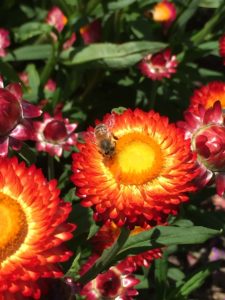 The transition from hobbyist gardener to full-time Market Gardener poses many very challenging questions. Land, water, and location are the most difficult to answer. Finding this property on Castle Rock Road answers all of these beautifully. Next would be crop planning and building the infrastructure which includes a post harvest wash and packing station. Having the capacity to offer fruits and vegetables directly to our neighbors provides us an opportunity to showcase produce in a way that has been lost to commercial agriculture. This alone eases the pressures of marketing. Fresh produce, just hours from harvest, is more nutritionally dense and is grown with love and an emphasis on quality over quantity. It tastes better because it is better. Having figured out these key pieces to the puzzle has enabled the farm to host a CSA or weekly share option, a farmstand twice a week during the growing season, and enjoy countless amazing interactions with our community.
The transition from hobbyist gardener to full-time Market Gardener poses many very challenging questions. Land, water, and location are the most difficult to answer. Finding this property on Castle Rock Road answers all of these beautifully. Next would be crop planning and building the infrastructure which includes a post harvest wash and packing station. Having the capacity to offer fruits and vegetables directly to our neighbors provides us an opportunity to showcase produce in a way that has been lost to commercial agriculture. This alone eases the pressures of marketing. Fresh produce, just hours from harvest, is more nutritionally dense and is grown with love and an emphasis on quality over quantity. It tastes better because it is better. Having figured out these key pieces to the puzzle has enabled the farm to host a CSA or weekly share option, a farmstand twice a week during the growing season, and enjoy countless amazing interactions with our community.
 But, it frustratingly hasn’t been all beautiful birds, bees, and butterflies. Bugs, and lots of them, have been a huge problem. Add in the gophers, deer, disease and serious weed pressure, and pest mitigation becomes a very puzzling ordeal. As an organic farm, we abhor the idea of using any sort of chemical pesticide, herbicide or any type-of-cide. So how are there so many successful organic farms? And, what are they up to in terms of answering these complex problems?
But, it frustratingly hasn’t been all beautiful birds, bees, and butterflies. Bugs, and lots of them, have been a huge problem. Add in the gophers, deer, disease and serious weed pressure, and pest mitigation becomes a very puzzling ordeal. As an organic farm, we abhor the idea of using any sort of chemical pesticide, herbicide or any type-of-cide. So how are there so many successful organic farms? And, what are they up to in terms of answering these complex problems?
The answer begins with a startling fact. Tillage, so common that it is almost synonymous with farming, is the worst thing we are doing to our soil. By tilling soil we are obliterating an entire microbial food web that has spent millions of years evolving to form symbiotic relationships with plants. These microbes form a dynamic community of bacteria, protozoa, nematodes, and fungi, all of which are crucial to breaking down organic matter and minerals into the nutrients our plants require. It is the presence of this soil food web that builds healthy soil by numerous biological processes. A healthy soil will produce healthy plants that are naturally capable of defending itself from bugs and disease and will not require any toxic pesticides.
 Upon learning about how soil functions and about how detrimental its disturbance is, we immediately disconnected our formerly beloved tiller attachment. Oh, the bed is full of weeds? Till it. It’s time to turn a crop in? Till it. The flea beatles have taken over? Till it. Just this alone explains, perhaps, all of our pest problems. We were using the tiller to treat symptoms, not understanding the root cause of the issues. We were seeing poorer and poorer fertility, not because we needed to add more and more fertilizer, but because we had destroyed the ability for the soil to function. We were guilty of fighting against nature due to not understanding its language. We realized that soil is not to be treated as a machine. It is an entire ecosystem requiring love and attention to details.
Upon learning about how soil functions and about how detrimental its disturbance is, we immediately disconnected our formerly beloved tiller attachment. Oh, the bed is full of weeds? Till it. It’s time to turn a crop in? Till it. The flea beatles have taken over? Till it. Just this alone explains, perhaps, all of our pest problems. We were using the tiller to treat symptoms, not understanding the root cause of the issues. We were seeing poorer and poorer fertility, not because we needed to add more and more fertilizer, but because we had destroyed the ability for the soil to function. We were guilty of fighting against nature due to not understanding its language. We realized that soil is not to be treated as a machine. It is an entire ecosystem requiring love and attention to details.
So, a new adventure begins. Out goes the tiller, and in comes the microscope. We spent the entire winter bunkered down to scour the internet for information and guidance. What we discovered was amazing. Researchers, scientists, professional farmers and amateur gardeners alike have entered into a new era of understanding when it comes to soil science and plant health. We are in the midst of an agricultural revolution and Castle Rock Farm is striving to find itself perched right on the frontier.
 Acquiring a shadowing microscope has been an eye opening and profound experience. For the first time we can actually see with our own eyes what a functioning soil looks like. We can identify the different trophic levels of the food web and we have the ability to work towards and then maintain soil health without having to blindly guess. After just 6 months of focusing on biology and ceasing the act of tillage, we have seen extremely promising results. We are seeing a significant reduction in soil compaction through the use of cover crops and weed pressure is much more manageable. We do still have a lot to learn to completely restore balance, but seeing results and having a more comprehensive understanding of these ideas has had the effect of turning these obstacles into a fun and fulfilling challenge.
Acquiring a shadowing microscope has been an eye opening and profound experience. For the first time we can actually see with our own eyes what a functioning soil looks like. We can identify the different trophic levels of the food web and we have the ability to work towards and then maintain soil health without having to blindly guess. After just 6 months of focusing on biology and ceasing the act of tillage, we have seen extremely promising results. We are seeing a significant reduction in soil compaction through the use of cover crops and weed pressure is much more manageable. We do still have a lot to learn to completely restore balance, but seeing results and having a more comprehensive understanding of these ideas has had the effect of turning these obstacles into a fun and fulfilling challenge.
For questions and comments, please feel free to contact Alex and Tony at castlerockfarmstand@gmail.com. Visit our website at www.castlerockfarmstand.com. Visit our farmstand open Tuesdays and Saturdays from 10am – 5pm every week.
By Alex Ellison, Resident since 2019
